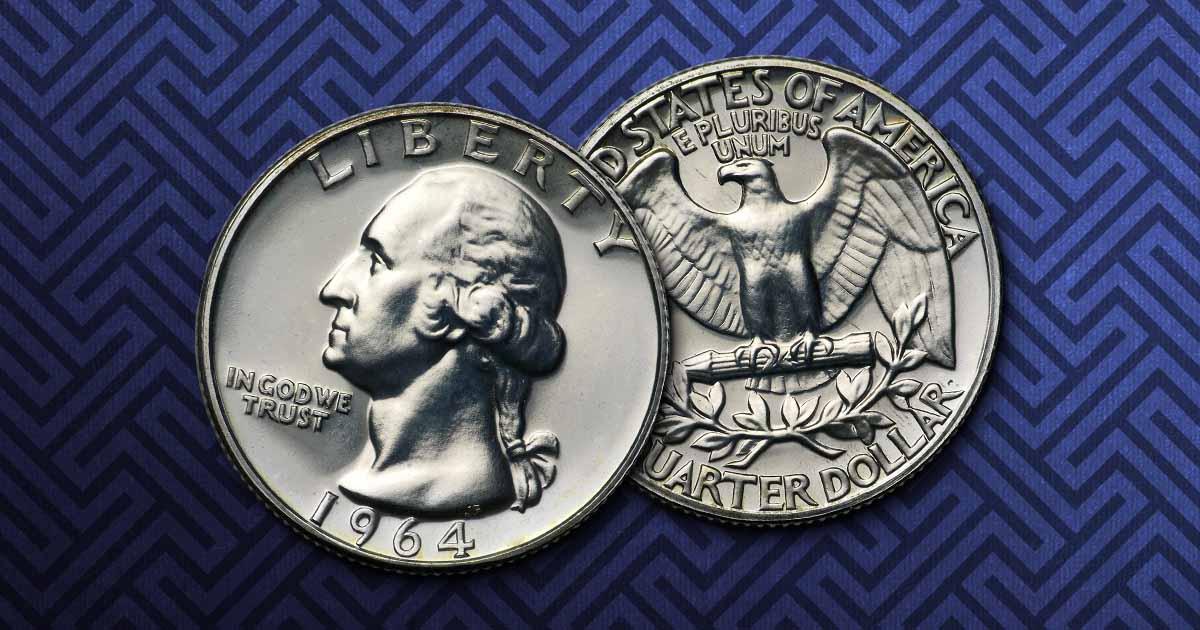
Finding a coin’s silver content requires multiplying the coin’s total weight, which is 6.25 grams, by 0.90, which is the proportion of silver in the coin. The 1964 Washington Quarter has 5.625 grams or about one-fifth of a troy ounce of silver. Their composition was 90% silver and 10% copper, with copper used to strengthen the coin.
Were All U.S. Quarters Silver Until 1964?
From the first Draped Bust Quarter in 1796 through the 1964 issue of the Washington Quarter, U.S. quarter dollars were made with a high silver content, though not all issues are exactly 90% silver.
Quarters issued before 1838, like the Draped Bust and Capped Bust Quarters, weighed 6.682 grams each and were minted with 89.24% fine silver. The weight was revised to 6.25 grams with 90% silver in 1838, and that standard continued until 1964.
Except for the 1976 bicentennial quarter, quarters issued in 1965 and after are composed of copper cores clad with cupronickel.
How Much Are 1964 Quarters Worth?
Whether you are assessing the value of a 1964 quarter or another coin, finding its total silver content is essential for determining its melt value. We know that the 1964 Washington Quarter has 5.625 grams of silver.
The price of a gram of silver is $0.72 today, so the melt value of a 1964 quarter would be about $4 and change. This does not take numismatic value into account, and depending on the state of the coin, it could be worth more than its melt value.
Why did the U.S. Mint Eliminate Silver from Circulating Coins?
Several factors contributed to the elimination of 90% silver quarters and dimes.
While the U.S. Bureau of the Mint worked to alleviate the woes that created a 1959 coin shortage, the demand for silver coins remained high, and the shortage persisted.
By the 1962 holiday shopping season, some denominations of coins were becoming scarce. While these coins would have worked their way back to the Mint or banks later in the winter of previous years, this did not happen in 1962. In response, the U.S. Mint authorized a new Philadelphia Mint and increased production with shifts that ran around the clock. However, the new Mint opening date was pushed back from 1966 to 1967 and did not open until 1969.
This effort did not solve problems in 1963 when all denominations of coins were rationed amidst the nationwide coin shortage. Commercial banks and their retail customers received fewer coins than they needed for business.
Other factors, like growing industrial uses, expansion of the global economy, and surges in investment demands for silver, resulted in rising silver prices.
Americans became concerned about inflation and began holding more tightly to tangible assets like silver, which resulted in many silver coins being withdrawn from circulation. Many silver coins were held onto by those who believed the price of silver would continue to rise.
Likewise, banks and businesses preparing for greater shortages were retaining their coins. This hoarding of silver U.S. coins accelerated the depletion of government stockpiles used to mint silver coins to the degree that the supply of silver threatened to run dry by 1968.
These matters were compounded by the release and subsequent hoarding of the 1964 Kennedy Dollar. It is estimated that one third of the 202.5 million ounces of silver struck into Kennedy Half Dollars did not circulate. Those 8.6 million coins did not enter circulation to provide reprieve for businesses in dire need of coins to make change, which left stores and banks in competition for coins.
The Coinage Act of 1965
All these factors led to the creation and passing of the Coinage Act of 1965, enacted on July 23.
In June of 1965, President Lyndon B. Johnson asked Congress to pass legislation that provided a dime and quarter made from a base metal. The silver coinage being minted came from shrinking silver stocks instead of from freshly minted silver. The President argued that the silver needed by industry should not be wasted as a means of economic exchange.
The Coinage Act of 1965 eliminated silver in dimes and quarters and reduced the half dollar’s silver content from 90% to 40%. Mint officials had already conducted test runs of clad coinage with copper-nickel faces and copper cores to replace the silver coins and had no issues in production.
The new copper-nickel coins began circulating late in 1965 and passed side by side with the silver coins of the time.




